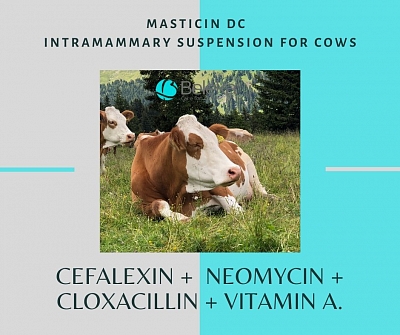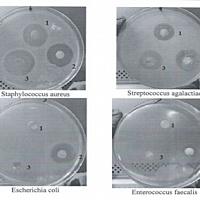Intramammary antibiotic treatment at drying off

There are many mastitis treatment options on the market. In many instances, it is difficult to make a right decision: this may include an assessment of cow somatic cell count results, clinical mastitis records and antibiotic responses on your farm.
Masticin DC is a combination of antibiotics and Vitamin A:
200 mg Cefalexin + 340 mg Neomycin + 500 mg Cloxacillin + 10 000 IU Vitamin A
Intramammary suspension for cows.
One-step drying off and treatment of mastitis caused by bacteria sensitive to the active ingredients in cows at drying off. Masticin DC is formulated for cows that had long lactating period and/or suffered from mastitis right before drying-off.
Masticin DC is a combination of Cefalexin, Neomycin and Cloxacillin which exhibits prolonged bactericidal activity against most mastitis causing pathogens including penicillin-resistant strains. It provides an extended spectrum of efficacy against both Gram-negative and Gram-positive bacteria Streptococcus spp., Staphylococcus spp., (including Staphylococcus aureus), Corynebacterium pyogenes, Escherichia coli, Pseudomonas spp., Leptospira spp., Campylobacter foetus, Actinomyces spp., Clostridium spp.
Cefalexin represents a first generation cephalosporin and belongs to the class of ß-lactam antibiotics. It provides a mainly time-dependent antibacterial activity against Gram-positive pathogens by inhibiting the synthesis of the bacterial peptidoglycan cell wall.
Neomycin sulfate is a broad-spectrum first generation aminoglycoside antibiotic. It inhibits bacterial protein synthesis through irreversible binding to the 30 S ribosomal subunit of susceptible bacteria. Action of penicillins enhances uptake of aminoglycosides by bacterial cells.
Cloxacillin is a member of the Beta-lactam group and is active against penicillin G resistant staphylococci. It binds to membrane bound proteins known as PBP's (Penicillin-binding proteins) that are located beneath the cell wall, thereby disrupting cell walls synthesis. Cloxacillin is bactericidal.
Vitamin A takes part in redox reactions, stimulates regeneration of udder cisternal tissues and reduces impact of inflammation and helps maintain tissue integrity.
Priority groups for the use of the Masticin DC:
- cows with long lactating period (longer than 305 days)
- cows suffered from mastitis right before drying-off
- high incidence rate of subclinical mastitis associated with Staphylococcus aureus on farm
Advantages of Masticin DC:
- new antibiotic combination with higher efficacy against bacteria
- high antimicrobial activity against Staphylococcus aureus
- stimulates regeneration of secretory tissue in the udder
- great for drying off problem cows
Masticin DC promotes quarters badly affected by an infection and long lactation to recover and become productive again in the next season. In some cases, much better clinical cure results are achieved when antibiotic treatment occurs at drying-off rather than during lactation.
Antibiotic components of Masticin DC aim to prevent new udder infections in the early dry period and can eliminate sub-clinical infections persisting from the previous lactation.
Vitamin A, as an ingredient of Masticin DC, takes part in redox reactions, stimulates regeneration of udder cisternal tissues, reduces impact of inflammation and helps maintain tissue integrity.
|
Comparison of bactericidal activity: |
|||||
|
Product |
Growth inhibition zone, mm |
||||
|
Staphylococcus aureus |
Streptococcus agalactiae |
Escherichia coli |
Enterococcus faecalis |
Other bacterial strains isolated from mastitis milk samples |
|
| Masticin DC | 21 | 18 | 10 | - | 19 |
| Mastifon | 24 | 22 | 23 | 15 | 19 |
| Mastilox | 27 | 20 | - | 10 | 22 |
Note: Growth inhibition zone of more than 21 mm - high sensitivity; 16-20 mm - normal sensitivity; 11-15 mm - low sensitivity, less than 10 mm – resistant.
Masticin DC is indicated for the one-step drying off 60 days before calving. It is well distributed in the udder and remains at therapeutic range for 45 days.
Summary is prepared by Sergej Sinkevich, Veterinary physician, Chief expert of Beleka Ltd.

